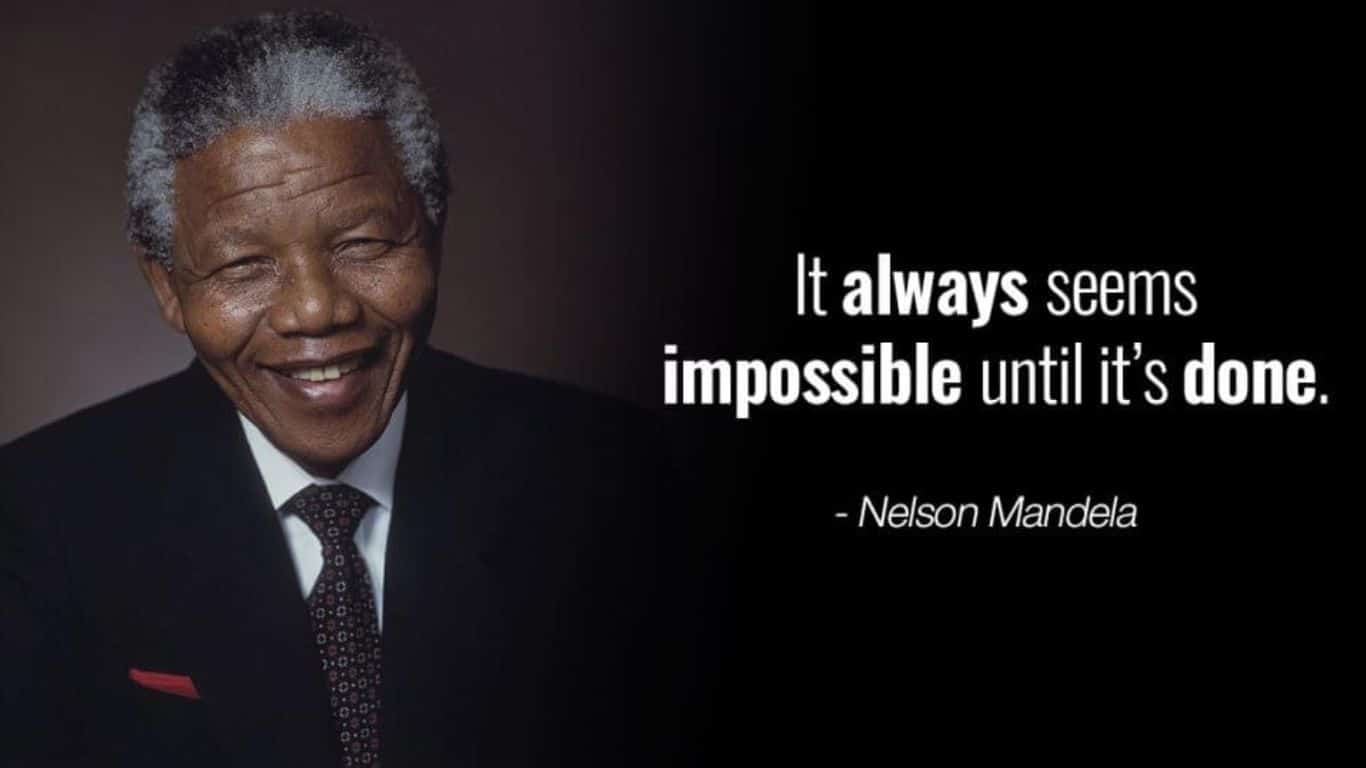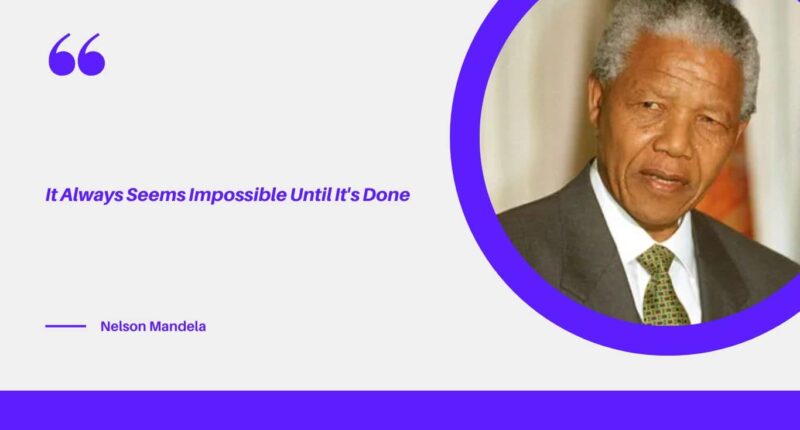Nelson Mandela, the iconic leader and symbol of freedom, once said, “It always seems impossible until it’s done”. These profound words encapsulate the essence of human resilience, determination, and the power of overcoming seemingly insurmountable obstacles. Mandela’s life and struggles serve as a testament to the enduring spirit of perseverance, inspiring generations to defy the odds and achieve the impossible.
In a world often clouded by doubt and uncertainty, Mandela’s quote resonates deeply, urging us to question our preconceived notions of what is achievable. Whether applied to personal aspirations, professional endeavors, or societal change, the wisdom contained in these words serves as a guiding light, propelling us forward when faced with daunting challenges.
This article will delve into the significance of Mandela’s quote, exploring its context, the psychology behind perceived limitations, and the transformative power of shifting our perspectives. Drawing upon Mandela’s extraordinary life, we will uncover the invaluable lessons he imparted through his leadership and examine how we can apply his wisdom to our own lives.
Understanding the Context of the Quote
To truly grasp the power and significance of Nelson Mandela’s quote, it is essential to delve into the historical context in which it emerged. Nelson Mandela, a South African anti-apartheid revolutionary and politician, dedicated his life to dismantling the oppressive system of racial segregation that plagued his country for decades.
Born in 1918, Mandela witnessed firsthand the injustices perpetuated by apartheid, which enforced discriminatory laws, denied basic rights to Black South Africans, and perpetuated a system of racial inequality. Mandela became an influential leader and a key figure in the fight against apartheid, advocating for peaceful resistance and equality.
However, Mandela’s journey towards liberation was far from easy. In 1964, he was sentenced to life imprisonment for his activism, spending 27 years behind bars. Despite the physical confinement, Mandela remained unwavering in his pursuit of justice, using his time in prison to educate himself, build resilience, and maintain hope for a better future.
Mandela’s quote, “It always seems impossible until it’s done,” encapsulates the essence of his experience and the spirit that guided his struggle against apartheid. It reflects the idea that when faced with immense challenges and seemingly insurmountable odds, the path to success often appears impossible from the outset. However, through perseverance, determination, and unwavering belief, the impossible can transform into reality.
These words resonate beyond the context of Mandela’s fight against apartheid, serving as a universal reminder of the power of human resilience and the capacity to overcome obstacles in various aspects of life. Whether it is pursuing personal goals, striving for professional success, or advocating for social change, Mandela’s quote encourages us to challenge our own perceptions of what is achievable and embrace the journey of turning impossibilities into possibilities.
The Psychology of Perceived Limitations
Human beings have a tendency to view challenges and goals through the lens of perceived limitations. This phenomenon often stems from a combination of factors, including fear, self-doubt, societal conditioning, and past experiences of failure. As a result, we tend to believe that certain endeavors are impossible even before attempting them.
Fear plays a significant role in shaping our perceptions of what is achievable. The fear of failure, rejection, or disappointment can create a mental barrier that hinders us from venturing into uncharted territories. We may convince ourselves that the risk is too great or that we lack the necessary skills or resources to succeed. This fear-based thinking limits our potential and keeps us confined within our comfort zones.
Self-doubt is another psychological factor that contributes to our perception of limitations. We may underestimate our abilities, doubt our competence, or believe that we are not deserving of success. These negative self-perceptions can lead to a self-fulfilling prophecy, where we sabotage our own progress before even attempting to pursue our goals.

Societal conditioning also plays a significant role in shaping our beliefs about what is possible. We are often influenced by societal norms and expectations, which can impose limitations on our aspirations. Messages such as “that’s impossible” or “it’s never been done before” can discourage us from pursuing unconventional paths or challenging the status quo.
Past experiences of failure or setbacks can reinforce our belief in limitations. When we have faced previous disappointments or encountered obstacles that seemed insurmountable, we may develop a sense of learned helplessness. This mindset convinces us that similar challenges will always yield the same outcome, preventing us from attempting them again.
However, it is crucial to recognize that perceived limitations are not an accurate reflection of our true potential. They are often rooted in subjective beliefs and psychological barriers rather than objective reality. Countless examples from history and personal experiences demonstrate that what initially appears impossible can indeed be accomplished.
Shifting Perspectives: From Impossible to Achievable
While it’s natural to perceive certain goals or challenges as impossible at first glance, it is within our power to shift our perspectives and embrace the possibility of achieving them. By challenging our limiting beliefs and adopting a mindset of possibility, we can unlock our true potential and accomplish what initially seemed unattainable. Here are some strategies for shifting our perspectives:
- Set Realistic Goals: Break down the seemingly impossible task into smaller, achievable milestones. By setting realistic and measurable goals, we can track our progress and build momentum over time. Each step forward reinforces the belief that what once seemed impossible is now within reach.
- Seek Support and Inspiration: Surround yourself with a supportive network of individuals who believe in your abilities. Seek out mentors, coaches, or like-minded peers who can provide guidance, encouragement, and inspiration along the way. Their belief in you can help counteract self-doubt and fuel your motivation.
- Embrace Failure as a Stepping Stone: Shift your perception of failure from being an endpoint to being a valuable learning experience. Understand that setbacks and mistakes are part of the journey towards success. Embracing failure as a stepping stone allows you to learn, grow, and adjust your approach to overcome challenges.
- Cultivate a Growth Mindset: Adopt a mindset that believes in the power of continuous growth and development. Recognize that abilities and skills can be developed through effort, practice, and learning. By embracing a growth mindset, you open yourself up to new possibilities and expand your potential beyond perceived limitations.
- Draw Inspiration from Others’ Success: Study the stories of individuals who have accomplished what was once deemed impossible. Understand their journeys, the obstacles they overcame, and the mindset that propelled them forward. Drawing inspiration from their success can instill belief in your own ability to achieve the seemingly impossible.
- Visualize Success and Affirm Your Potential: Utilize the power of visualization to imagine yourself succeeding and achieving your goals. Visualize the steps, challenges, and ultimate triumph. Combine this practice with positive affirmations that reinforce your potential and shift your mindset from doubt to belief.
- Take Action and Iterate: Break the cycle of analysis paralysis and take consistent action towards your goals. Start with small steps and build momentum. Adjust your approach along the way, learning from each experience. Action breeds confidence and helps overcome the inertia of perceived limitations.
Conclusion
Nelson Mandela’s quote, “It always seems impossible until it’s done,” serves as a timeless reminder of the power of perseverance, resilience, and the ability to overcome seemingly insurmountable obstacles. By understanding the context in which this quote emerged and exploring the psychology behind perceived limitations, we can begin to shift our perspectives and embrace the possibilities that lie beyond our initial doubts.
Also Read: The Secret to Getting Ahead is Getting Started



